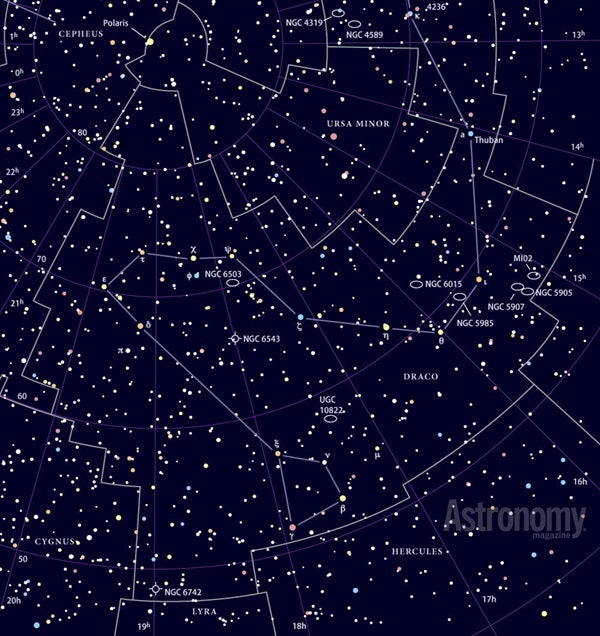Targets for August 6–13, 2015
Small telescope:
Zeta (ζ) and Beta (β) Lyrae
Small telescope:
Globular cluster M70
Large telescope:
Planetary nebula NGC 6742
Two treats in one constellation
This week’s first small-telescope target is a pair of stars worthy of a look that lie in the constellation Lyra the Harp. The first is Zeta (ζ) Lyrae.
This pretty binary combines a magnitude 4.3 light-blue primary with a magnitude 5.9 pale-yellow or yellowish-white secondary. This magnitude difference translates into the main star being slightly more than four times as bright as its companion. Any telescope will split this bright, wide pair. Its separation is 44″.
The second of my Lyra picks is Sheliak (Beta [β] Lyrae). Sheliak is the prototype for a class of variable stars. Beta Lyrae-type variables are eclipsing binary stars.
Normally, this pair shines at magnitude 3.3. But every 12.936 days, the larger star totally eclipses its smaller companion to produce the system’s minimum magnitude of 4.3. Half the period later, the smaller star occults part of the larger one. This generates a secondary minimum of about magnitude 3.8. Beta Lyrae also is a double star with a magnitude 8.6 secondary located 46″ away.
This star’s proper name is easy enough to explain. According to Richard Hinckley Allen in Star-Names and Their Meanings, it comes from Al Shilyak, one of the Arabian names for Lyra.
That’s no comet
This week’s second small-scope object is globular cluster M70 in Sagittarius. This southerly Messier object lies midway between magnitude 2.6 Ascella (Zeta [ζ] Sagittarii) and magnitude 1.8 Kaus Australis (Epsilon [ε] Sagittarii).
Magnitude 7.8 M70 (NGC 6681) is similar in brightness to M69, which I discussed in an earlier podcast, but M70 has a more sharply concentrated center. A 4-inch telescope at a magnification of 100 frames this object nicely. The cluster measures 7.8′ across.
Step up to an 8-inch scope at 200x, however, and you’ll see a bright core and a thin halo in which you can resolve a half-dozen stars.
A short line of relatively bright stars shoots northward from the cluster’s eastern side.
M70 has an association with Comet C/1995 O1 (Hale-Bopp), which achieved naked-eye brilliance for several months in 1997. Neither discoverers Alan Hale nor Thomas Bopp was actively comet-hunting when he made his independent find July 23, 1995. The pair merely pointed telescopes at M70 and spotted a foreign object in the field of view.
Round and tiny, but easy to spot
This week’s large-telescope target is planetary nebula NGC 6742 in Draco. This relatively neglected object, also known as Abell 50, lies near Draco’s southern borders with Cygnus and Lyra. Unfortunately, it doesn’t lie close to any bright star. To find NGC 6742, first find the magnitude 5.0 star 16 Lyrae. Then look 1.5° north-northwest.
Although the nebula’s magnitude — 13.4 — implies that it’s quite faint, the surface brightness is high enough for you to easily view it through a 10-inch telescope. It appears as a sharp-edged, round disk 30″ in diameter. Increase the magnification and try to spot the ring structure in this object.
Expand your observing at Astronomy.com
StarDome
Check out Astronomy.com’s interactive StarDome to see an accurate map of your sky. This tool will help you locate this week’s targets.
The Sky this Week
Get a daily digest of celestial events coming soon to a sky near you.
Observing Talk
After you listen to the podcast and try to find the objects, be sure to share your observing experience with us by leaving a comment at the blog or in the Reader Forums.











